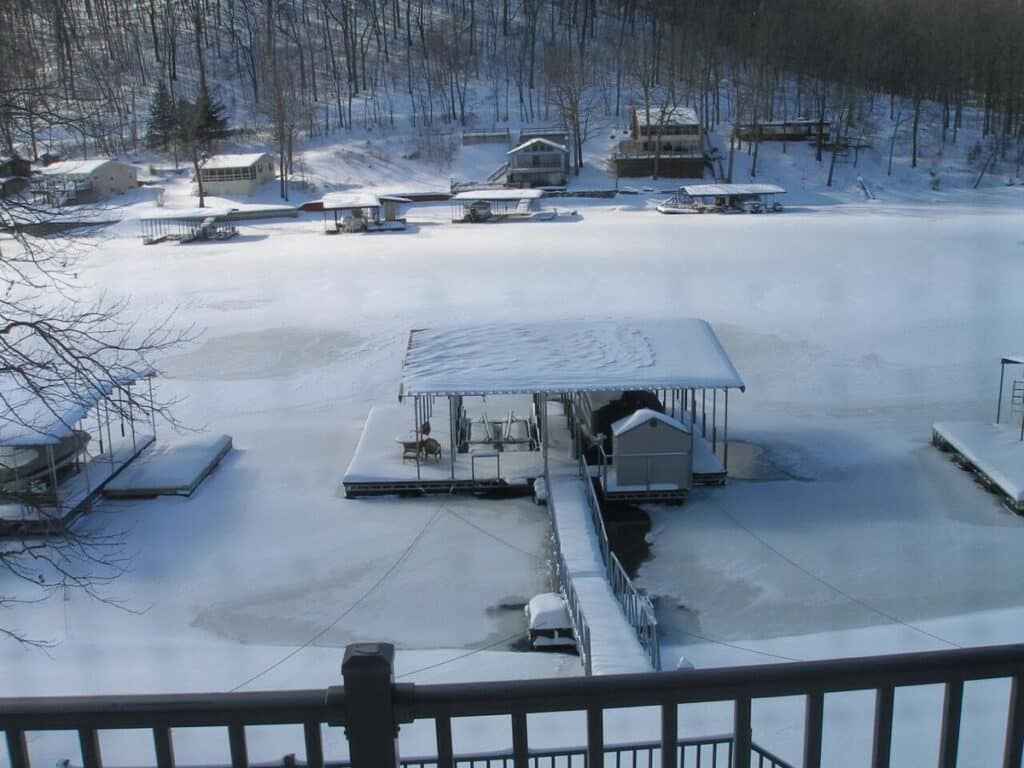
Introduction
Winter around Badin, Tillery, and High Rock Lakes carries its own personality. While the lakes get quieter, your boat enters its highest-risk season — even though it’s not being used. Cold fronts, temperature swings, storms, fluctuating water levels, and wind patterns all influence your boat’s health. All of these factors determine how boat owners prepare and protect their boat through winter.
This expanded guide goes deeper than a standard checklist. You’ll learn the *why* behind each step, how winter conditions actually affect your boat, and what smart lake homeowners do between November and March to prevent damage, preserve boat value, and avoid expensive surprises in April.
How Winter Actually Damages Boats
Winter is not ‘downtime’ for your boat — it’s stress season. Here’s what’s happening:
Temperature Cycling
Winter on NC and SC lakes includes rapid temperature changes. Days can hit the 50s or 60s, and nights can dip into the 20s or lower. This creates a dew-freeze-thaw cycle that produces interior moisture and expands water droplets into tiny cracks, stitching holes, and seams. Repeated expansion slowly weakens materials.
Moisture Intrusion
Moisture doesn’t need rain to get into your boat. Condensation alone can saturate fabrics and flooring. The more poorly fitted a cover is, the more moisture collects in specific pockets — and the longer it stays there.
Winter Winds on the Lakes
Badin, Tillery, and High Rock all see stronger winter gusts because shoreline foliage is bare and wind can travel across open water unobstructed. Wind loosens unsecured covers and accelerates fabric fatigue. A loose cover in January becomes a torn cover in February — and often a mildewed boat by March.
Wildlife Pressures
When temperatures drop, small animals look for shelter. Pontoons, engine compartments, and under-console areas become attractive nesting zones unless your cover seals properly.
A Complete Winter Prep Checklist
Below is a detailed prep list — with context for *why* each step matters.
1. Clean the Interior Thoroughly
A clean interior dries faster, traps less moisture, and prevents the formation of the organic material mold feeds on. Even light dust or dirt becomes fuel for mildew once condensation appears.
2. Remove All Damp or Porous Gear
Life jackets, towels, ropes, bags, and soft materials hold moisture longer than you think. Removing them cuts down moisture retention significantly.
3. Protect Electronics
Cold alone won’t harm most electronics, but moisture absolutely will. Ensure batteries are off and remove or protect portable units.
4. Vacuum and Ventilate Compartments
Compartments with even a teaspoon of trapped moisture can grow mold by February. A clean, dry compartment with airflow rarely has issues.
5. Check Drainage Paths
Drainage paths clogged with leaves or debris create standing water — the #1 catalyst for winter mold blooms.
6. Inspect Your Cover for Fit and Tension
Covers that sag, stretch, or flap are at high risk in winter. Wind pressure and freeze-thaw effects compound quickly. A well-tensioned cover prevents tearing and water intrusion.
7. Ventilation Matters More in Winter Than Summer
Even breathable fabrics need airflow. Winter moisture is slow to evaporate, so ventilation ports or system-style covers that promote air circulation drastically reduce mold risk.
Understanding Fabrics and Protection Systems
Different fabrics behave differently in winter. Canvas and cotton blends are cheaper but fail fast without vigilant drying in freeze-thaw conditions caused by fluctuating temperatures. Marine-grade fabrics like Aqualon® Edge balances high water resistances, strong UV resistance, mildew resistance, and lighter weight.
Custom and modern track-based cover systems like those from Marine Concepts improve winter performance through even tension, snug fit to the hull, and superior ventilation.
Boat Type Winter Difference
Wake Boats:
Deep hulls trap moisture, and tower structures create more complex cover geometry.
Pontoons:
Large surface area catches more wind. Wildlife intrusion is more common.
Fishing Boats:
Electronics, open layouts, and casting decks make dryness the top priority.
Boat type is a major factor in how boat owners prepare and protect their boat.
Traditional Covers vs. Cover Systems
Traditional snap or strap covers can work, but require more winter monitoring. They’re more prone to sagging, flapping, and moisture retention.
Cover systems like the World’s Best Boat Cover distribute tension perfectly and are custom built to each vessel to withstand wind and winter cycles. They also go on and off in under a minute while providing top-tier protection year round.
Why Winter Is the Smartest Time to Upgrade
During the off-season:
- Installers have more availability
- Lead times are shorter
- Cover production moves faster
- You avoid spring backlog
- You start the season with your boat exactly how you left it
Most lake homeowners who upgrade during the winter say they wish they’d done it sooner — winter damage is high risk and very expensive.
How to Tell If Your Cover Won't Make It to Spring
- Stitching looks fuzzy or frayed
- Small tears or pinholes (they grow quickly in winter)
- Fabric feels thin or brittle
- Water pools in the same place every rain
- You smell mildew every time the cover opens
- Snaps or straps fail frequently
Frequently Asked Questions
Q: Is winter really the high-risk season?
A: Absolutely. Most mold and mildew blooms occur between December and March.
Q: Do I need a full winterization if the boat stays on the lift?
A: Yes, especially for inboards.
Q: Can I install a cover system in winter?
A: Yes — the off-season is ideal.
Q: What’s the biggest winter mistake boat owners make?
A: Letting moisture stay trapped under a poorly fitted cover.
Requesting a Personalized Winter Protection Consult
Every dock, shoreline, slip, wind exposure, and boat layout on Badin, Tillery, and High Rock is different. A personalized consult assesses your current set-up to customize the optimal boat protection system for your investment.
Request a personalized winter protection consult below.

